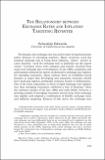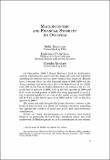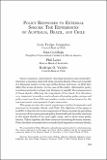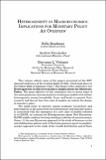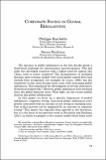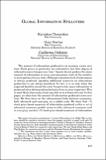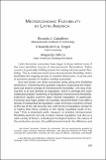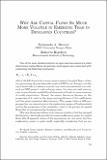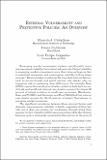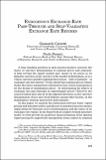Buscar
Mostrando ítems 1-10 de 32
The relationship between exchange rates and inflation targeting revisited
For decades, the exchange rate was at the center of macroeconomic policy debates in emerging markets. Many countries used the nominal exchange rate to bring down inflation, –others—mostly in Latin America—used the exchange rate to implicitly tax the export sector. Currency crises were common and usually ...
Macroeconomic and financial stability: an overview
On September 2008 Lehman Brothers filed for bankruptcy and the world became aware that the financial crisis that had been unfolding for months was far more serious than expected. Months later it became clear that the financial crisis of 2008-2009 was the worst economic downturn since the Great Depression ...
Policy responses to external shocks: the experiences of Australia, Brazil, and Chile
Open economies, particularly emerging markets and commodityintensive economies, deal with large external shocks. These are typically of a financial nature in the case of the former and real—in that they affect the terms of trade—in the case of the latter. Alternative policy reactions and policy setups ...
Heterogeneity in macroeconomics: implications for monetary policy an overview
This volume collects some of the papers presented at the XXV Annual Conference of the Central Bank of Chile, which took place in
November 2022 in Santiago, Chile.1 The theme of the conference was Heterogeneity in Macroeconomics: Implications for Monetary
Policy. The main objective of this conference ...
Corporate saving in global rebalancing
The increase in global imbalances in the last decade posed a theoretical challenge for international macroeconomics. Why did some less developed countries with a higher need for capital like China lend to richer countries? The inconsistency of standard dynamic open-economy models with actual global ...
Global information spillovers
The amount of information produced in an economy varies over time. Stock prices in particular are informative but their degree of informativeness changes over time. Agents do not produce the same amount of information in every macroeconomic state of the world or in anticipation of every state. Although ...
Microeconomic flexibility in Latin America
Latin American economies have begun to leave behind some of the most primitive sources of macroeconomic fluctuations. Policy concern is gradually shifting toward increasing microeconomic flexibility. This is a welcome trend since microeconomic flexibility, which facilitates the ongoing process of ...
Why are capital flows so much more volatile in emerging than in developed countries?
One of the most studied subjects in open macroeconomics is what determines capital flows. In general, most papers are concerned with estimating the following regression. where the left-hand side is some measurement of capital flows, either as a percentage of gross domestic product (GDP) or as changes, ...
External vulnerability and preventive policies: an overview
Emerging market economies endure significantly more macroeconomic volatility than industrial countries. Output volatility in emerging market economies is more than twice as large as that in industrial economies, and consumption volatility is three times as large. Recent studies corroborate the view ...
Endogenous exchange-rate pass-through and self-validating exchange rate regimes
A long-standing question in open macroeconomics concerns the choice of currency denomination of nominal prices and contracts. A firm serving the export market may choose to set prices in its domestic currency in the currency of the market of destination or in a vehicle currency possibly indexing these ...

